June 30, 2021 | Stephanie Janard (UMMC)
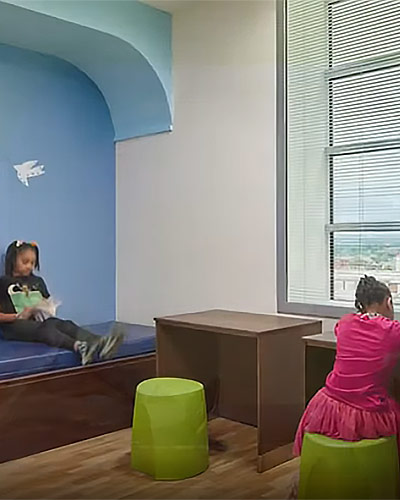
New unit eschews "institutional" look for a nature-themed, therapeutic environment
Children and teens experiencing acute mental health crises have a safe and healing space to recover in the newly-opened Children & Adolescent Psychiatric Unit at the University of Maryland Children's Hospital (UMCH). The 16-bed, state-of-the-art unit is the first in the state designed both architecturally and clinically to deliver "trauma-informed" care for children spanning 5 to 17 years old. Trauma-informed care is a framework for treating patients who have endured abuse, neglect, violence, school issues and other traumatic events—which not all, but many young patients have experienced.
A virtual "grand opening" of the new unit can be viewed on the University of Maryland Medical Center website.
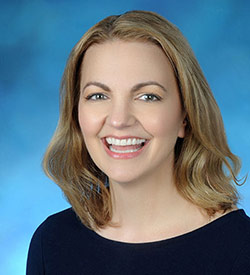 "The new unit is designed to provide crisis stabilization, respite and recovery for our most vulnerable patients—children and adolescents—and to instill hope that life will get better," said Sarah Edwards, DO, Director of Child and Adolescent Psychiatry at UMMC and Assistant Professor of Psychiatry at the University of Maryland School of Medicine (UMSOM).
"The new unit is designed to provide crisis stabilization, respite and recovery for our most vulnerable patients—children and adolescents—and to instill hope that life will get better," said Sarah Edwards, DO, Director of Child and Adolescent Psychiatry at UMMC and Assistant Professor of Psychiatry at the University of Maryland School of Medicine (UMSOM).
The need for mental health care among youth has become an urgent national issue. According to the CDC, children's mental health-related ED visits significantly increased in 2020, the first year of the pandemic, compared to 2019. In a screening of over 1.5 million people by Mental Health America uncovered alarming statistics about youth suicide ideation during the pandemic.
These rates were highest among youth, according to the report, which found that in September 2020, over half of 11-17-year-olds reported having thoughts of suicide or self-harm more than half or nearly every day of the previous two weeks. From January to September 2020, 77,470 youth reported experiencing frequent suicidal ideation, including 27,980 LGBTQ+ youth.
Prior to these findings, the Centers for Disease Control & Prevention published that almost 19% of high school students who responded to the agency's 2019 Youth Risk Behavior Survey indicated they had seriously considered suicide
Designed to heal
Patients in crisis will be able to receive psychiatric care for a range of conditions including:
- Trauma disorder (PTSD, acute stress disorder, adjustment disorder)
- Psychotic spectrum disorders (schizophrenia, substance-induced psychotic disorder)
- Mood disorders (depression and bipolar disorder)
- Anxiety disorders (phobias, panic disorder, social anxiety disorder, separation anxiety disorder)
- Co-morbid neurodevelopmental disorders (high-functioning autism spectrum disorder, mild intellectual disability)
- Attention Deficit Hyperactive Disorder
No matter the patient's condition, every intervention at the new unit is designed to not re-traumatize the child. Whether participating in a group therapy session, resting in their rooms, or tucked into a "chill alcove" gazing at a nature wall mural designed by local artist Annie Howe, patients are in an environment where they can manage intense emotions and unsafe urges, while learning adaptive behaviors and coping skills.
Architectural elements in the new unit feature soothing colors and nature themes, curved walls and lighting to mirror a child's circadian rhythm to promote restful sleep at night and optimal energy during the day for therapy and other activities. Wherever possible, patients are given the choices and control so often robbed from them in trauma-filled lives.
For example, by adjusting a switch on the wall patients can choose from different sounds to play in their room, such as running water, nature sounds, or music. Architecture and design for the new unit were provided by Baltimore firm Inquiry.
The new unit is staffed to provide multidisciplinary expertise in every facet of treatment and recovery. To maximize staff and patient interaction, the unit is designed with "on stage" and "off stage" areas, so that patient care is the focus in treatment areas, while other work like documentation, phone calls and team conversations happen "off stage."
Post-discharge, school transition specialists work to help connect patients and their families to vital services and peer support. This is part of a longstanding program at UMCH which has proven to actually reduce readmissions.
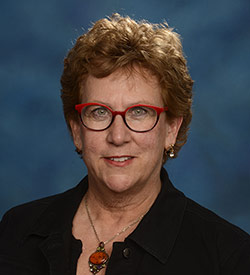 "The new Children and Adolescent Psychiatry Unit at University of Maryland Children's Hospital Children is an essential component of the continuum of care we offer to youth experiencing mental distress. "They are not alone in their struggle; we are here to help them recover and thrive, whether they need crisis stabilization at our new inpatient unit, or ongoing counseling at our outpatient psychiatry clinics," stated Jill RachBeisel, MD, Chief of Psychiatry at UMMC and Professor and Chair, Department of Psychiatry at UMSOM.
"The new Children and Adolescent Psychiatry Unit at University of Maryland Children's Hospital Children is an essential component of the continuum of care we offer to youth experiencing mental distress. "They are not alone in their struggle; we are here to help them recover and thrive, whether they need crisis stabilization at our new inpatient unit, or ongoing counseling at our outpatient psychiatry clinics," stated Jill RachBeisel, MD, Chief of Psychiatry at UMMC and Professor and Chair, Department of Psychiatry at UMSOM.
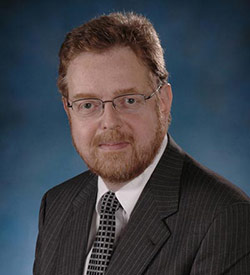 Steven J. Czinn, MD, Director of the University of Maryland Children's Hospital and the Drs. Rouben and Violet Jiji Endowed Professor and Chair, Department of Pediatrics at UMSOM, stated, "The thought and design that have gone into creating the inpatient psychiatric unit exemplifies our commitment to the whole health of children—mental, emotional and physical."
Steven J. Czinn, MD, Director of the University of Maryland Children's Hospital and the Drs. Rouben and Violet Jiji Endowed Professor and Chair, Department of Pediatrics at UMSOM, stated, "The thought and design that have gone into creating the inpatient psychiatric unit exemplifies our commitment to the whole health of children—mental, emotional and physical."
Senior leaders at both UMMC and UMSOM also offered their congratulations to the teams behind the new unit.
E. Albert Reece, MD, PhD, MBA, Executive Vice President for Medical Affairs, UM Baltimore, and the John Z. and Akiko K. Bowers Distinguished Professor and Dean, University of Maryland School of Medicine, said, "The attention given to every detail of the new Children & Adolescent Psychiatric unit is exceptional—from the design to staffing to implementation of an evidence-based recovery model of care. We expect that the unit will quickly make a meaningful improvement on the mental health and wellbeing of Baltimore and Maryland youth."
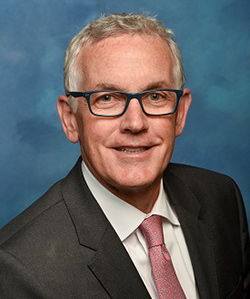 Bert W. O'Malley, MD, President and CEO of University of Maryland Medical Center, where UMCH is located, concluded, "Dr. Edwards and the psychiatry teams have worked tirelessly to bring this outstanding new addition to our children's hospital. Their dedication underscores our mission to be the children's hospital of choice throughout Maryland, offering a place of healing and hope for all of our young patients."
Bert W. O'Malley, MD, President and CEO of University of Maryland Medical Center, where UMCH is located, concluded, "Dr. Edwards and the psychiatry teams have worked tirelessly to bring this outstanding new addition to our children's hospital. Their dedication underscores our mission to be the children's hospital of choice throughout Maryland, offering a place of healing and hope for all of our young patients."
About the University of Maryland School of Medicine
Now in its third century, the University of Maryland School of Medicine was chartered in 1807 as the first public medical school in the United States. It continues today as one of the fastest growing, top-tier biomedical research enterprises in the world -- with 46 academic departments, centers, institutes, and programs, and a faculty of more than 3,000 physicians, scientists, and allied health professionals, including members of the National Academy of Medicine and the National Academy of Sciences, and a distinguished two-time winner of the Albert E. Lasker Award in Medical Research. With an operating budget of more than $1.2 billion, the School of Medicine works closely in partnership with the University of Maryland Medical Center and Medical System to provide research-intensive, academic and clinically based care for nearly 2 million patients each year. The School of Medicine has nearly $600 million in extramural funding, with most of its academic departments highly ranked among all medical schools in the nation in research funding. As one of the seven professional schools that make up the University of Maryland, Baltimore campus, the School of Medicine has a total population of nearly 9,000 faculty and staff, including 2,500 students, trainees, residents, and fellows. The combined School of Medicine and Medical System (“University of Maryland Medicine”) has an annual budget of over $6 billion and an economic impact of nearly $20 billion on the state and local community. The School of Medicine, which ranks as the 8th highest among public medical schools in research productivity (according to the Association of American Medical Colleges profile) is an innovator in translational medicine, with 606 active patents and 52 start-up companies. In the latest U.S. News & World Report ranking of the Best Medical Schools, published in 2021, the UM School of Medicine is ranked #9 among the 92 public medical schools in the U.S., and in the top 15 percent (#27) of all 192 public and private U.S. medical schools. The School of Medicine works locally, nationally, and globally, with research and treatment facilities in 36 countries around the world. Visit medschool.umaryland.edu
About the University of Maryland Medical Center
The University of Maryland Medical Center (UMMC) is comprised of two hospital campuses in Baltimore: the 800-bed flagship institution of the 13-hospital University of Maryland Medical System (UMMS) — and the 200-bed UMMC Midtown Campus, both academic medical centers training physicians and health professionals and pursuing research and innovation to improve health. UMMC's downtown campus is a national and regional referral center for trauma, cancer care, neurosciences, advanced cardiovascular care, women's and children's health, and has one of the largest solid organ transplant programs in the country. All physicians on staff at the downtown campus are clinical faculty physicians of the University of Maryland School of Medicine. The UMMC Midtown Campus medical staff is predominately faculty physicians specializing in diabetes, chronic diseases, behavioral health, long-term acute care and an array of outpatient primary care and specialty services. UMMC Midtown has been a teaching hospital for 140 years and is located one mile away from the downtown campus. For more information, visit www.umm.edu.
Contact
Stephanie Janard
University of Maryland Medical Center
Stephanie.janard@umm.edu
443-602-6937
